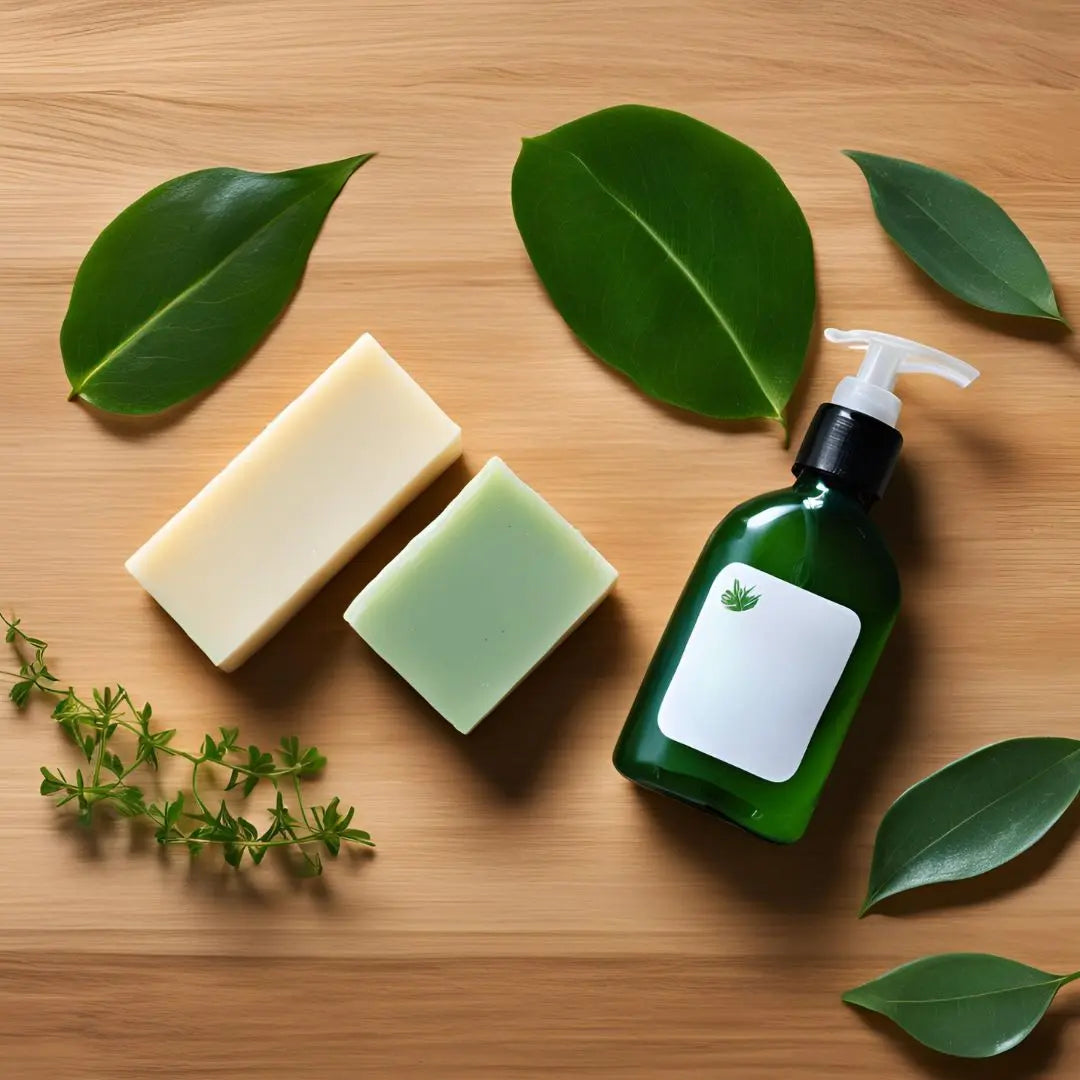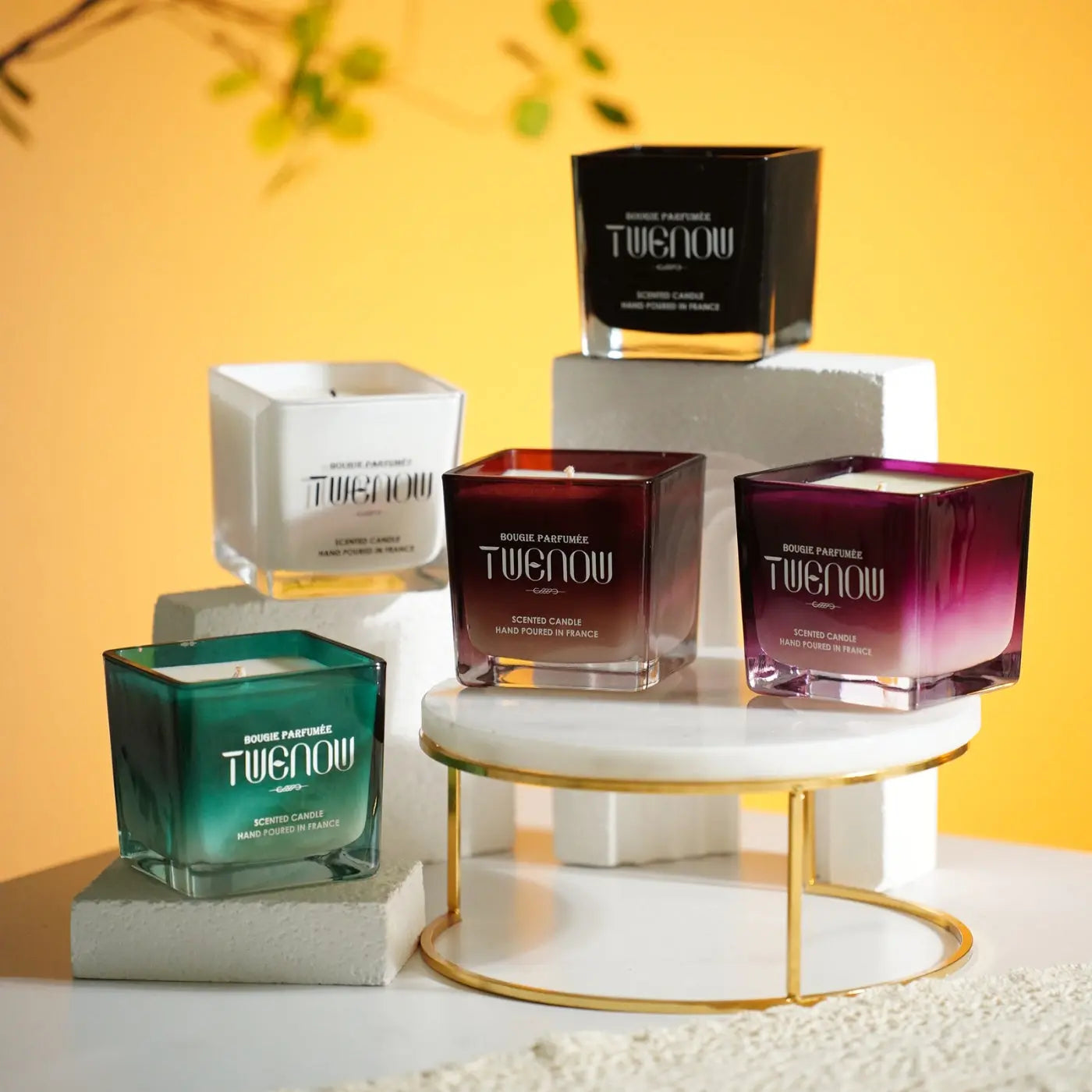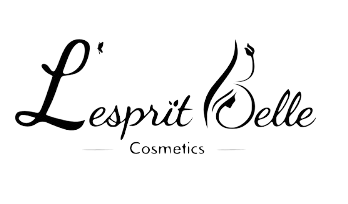
Solid or liquid soap: which is more eco-friendly?
Share
What is the ecological impact of your soap?
In our daily lives, many seemingly innocuous actions have unsuspected consequences for the environment. Among them, the use of soap, a product we all use, raises essential questions. What is the ecological impact of the soap we choose, whether solid or liquid? While both forms fulfill the same function—cleaning us—their manufacture, use, and end-of-life differ considerably, influencing their impact on the planet.
Bar soap, often associated with simplicity and sustainability, seems like the natural choice for those looking to reduce their environmental impact. Made with generally biodegradable ingredients and requiring little water, it's also valued for its longevity and lack of plastic packaging. Liquid soap, on the other hand, while extremely convenient, is often packaged in plastic bottles and contains additives that complicate its production process and increase its carbon footprint.
Let's take an example: Imagine a family of four using liquid soap year-round. That's dozens of discarded plastic bottles, often unrecycled packaging that ends up in landfills. Conversely, that same family could drastically reduce its waste by switching to solid soaps, sold without packaging or made from recyclable materials. These small changes can, on a large scale, make a big difference for the planet.
But it's not just the packaging that matters. Ingredients also play a major role in soap's environmental impact . Liquid soaps sometimes contain components like sulfates or parabens, which, once released into wastewater, harm aquatic ecosystems. In contrast, handmade solid soaps, often made from natural vegetable oils, are designed to be biodegradable and therefore much less harmful to the environment.
With growing awareness of these issues, more and more consumers are turning to eco-friendly products. But how can you make the right choice between solid and liquid soap? In this article, we will explore the fundamental differences between these two types of soap to better understand their ecological impact , from their manufacture to their use, including their ingredients and their end of life.
Ready to adopt more sustainable solutions? Discover our collection of TWENOW eco-friendly solid soaps now and make a simple but significant step to reduce your ecological footprint.
Choosing the right soap is more than just a routine: it's a commitment to the planet.
I. Manufacturing: a question of resources and environmental impact
The way a soap is made plays a major role in its environmental impact . The production processes for solid and liquid soaps differ considerably, directly influencing their environmental footprint. Let's analyze these differences to better understand their effects on our planet.
1.1: How are solid soaps made?
Solid soap is often associated with artisanal production, which is more environmentally friendly. Made through saponification, a simple process that combines vegetable or animal oils with an alkaline base (such as lye), it requires few resources. Unlike liquid soaps, its production consumes less water and generates less waste.
Let's take a concrete example: a local artisan who produces 100 solid soaps . He favors vegetable oils from local agriculture, such as olive or coconut oil, and packages his products in recyclable kraft paper. This process not only reduces the carbon footprint linked to the transport of raw materials, but also minimizes unnecessary packaging. Compared to a large industrial factory producing liquid soap, this artisan considerably limits waste.
By choosing solid soaps, we are therefore opting for a solution that is often more respectful of natural resources.
Discover our collection of eco-friendly TWENOW solid soaps and adopt a sustainable lifestyle today.
1.2: The liquid soap process, more energy-intensive
Liquid soap, while convenient, requires a much more complex and energy-intensive manufacturing process. To achieve a smooth, even texture, manufacturers add texturizing agents, preservatives, and sometimes synthetic fragrances. This process requires specialized equipment, greater water consumption, and generates more industrial waste.
According to a recent study, liquid soap can contain up to 20% more water than solid soap, increasing its environmental footprint. In addition, it is often packaged in plastic bottles, which increases its environmental impact.
For example, imagine industrial production of liquid soap. Each liter requires additional resources for mixing, packaging, and transportation, not to mention the emissions associated with manufacturing the plastic containers. These practices contrast sharply with those of solid soap, where energy and material requirements are reduced.
Explore natural and sustainable alternatives with our TWENOW range and reduce your ecological impact.
1.3: The impact of ingredients on the environment
Beyond the manufacturing process, the ingredients used in liquid and solid soaps also influence their environmental impact . Liquid soaps often contain controversial components, such as sulfates or parabens, which can be harmful to aquatic ecosystems. These substances, after use, end up in wastewater and are difficult to remove.
On the other hand, many solid soaps are made with natural and biodegradable ingredients, such as essential oils or vegetable butters. These components degrade easily in the environment, reducing their impact.
To illustrate this, let's take an example: a liquid soap containing sulfates released into the water can generate micropollutants that disrupt marine ecosystems. In comparison, a solid soap made from biodegradable vegetable oils dissolves naturally without harming aquatic life.
By opting for natural solid soaps, you help protect biodiversity while meeting your daily needs.
Make an informed choice with our TWENOW chemical-free soaps and take care of the planet.
II. Packaging: Plastic versus Minimalism
Packaging plays a fundamental role in the ecological impact of soap . Whether solid or liquid, the choice of packaging material and its end of life greatly influence a product's environmental footprint. While liquid soaps are often associated with plastic packaging, solid soap can be packaged in much more environmentally friendly materials, such as recyclable cardboard. Let's take a closer look at how these differences influence our consumer choices.
2.1: The scourge of plastic packaging for liquid soaps
Liquid soaps are mostly sold in plastic bottles. This material, despite its advantages in terms of lightness and practicality, is a real scourge for the environment. Plastic takes hundreds of years to decompose and, in many cases, is not even recycled properly. In addition to the pollution generated, the production of plastic bottles requires a large amount of energy and natural resources, contributing to the increase in CO2 emissions.
Let's take an example to illustrate: the average family uses 10 bottles of liquid soap per year . That's 10 plastic containers thrown away each year. Over five years, that's 50 bottles added to the mountain of plastic waste. When you think about it on a global scale, these figures take on a whole new dimension and reveal the enormous ecological impact of this type of packaging.
To reduce this impact, it is important to rethink our consumption habits and favor more ecological solutions.
Call to action: Reduce your plastic footprint with our solid soaps packaged in TWENOW recyclable cardboard.
2.2: Eco-responsible packaging for solid soap
One of the main advantages of solid soap is its packaging, which is often much more environmentally friendly than that of liquid soap. Rather than being enclosed in a plastic bottle, solid soap is often packaged in recyclable cardboard , a lightweight and biodegradable material that has a minimal impact on the planet.
Take our range of solid soaps , for example, which are carefully packaged in recyclable cardboard boxes, providing adequate protection while being easy to recycle after use. Once your soap is finished, you can throw the packaging in the recycling, without worrying about the accumulation of plastic waste. This approach helps limit pollution while facilitating efficient recycling.
Opting for solid soaps with recyclable cardboard packaging is an eco-responsible choice that helps reduce the use of plastic.
Go minimalist with our selection of solid soaps packaged in recyclable TWENOW cardboard.
2.3: An alternative for liquid soap packaging
For those who don't want to give up liquid soap, there are now alternative solutions to minimize the environmental impact of soap packaging. More and more brands are offering refill options for liquid soaps, which reduce the need for new plastic bottles. These refills are often contained in bags or packaging made from more environmentally friendly materials, such as recyclable bags or recycled plastic bottles.
A good example of this evolution is the emergence of bulk stations for liquid soap, where consumers can fill their own containers with soap. This system drastically reduces plastic consumption and optimizes the reuse of existing bottles.
This innovative approach, although still uncommon, is an interesting alternative for those who wish to continue using liquid soap while having a less harmful impact on the environment.
Explore our TWENOW solid products.
III. Use: economy and practicality in everyday life
Beyond their manufacturing and packaging, the use of solid and liquid soaps plays a central role in the ecological impact of soap . Sustainability, practicality, and water consumption are all criteria that influence our daily choices. Let's analyze how these two options perform in everyday life.
3.1: Solid soap, more durable and economical
Solid soap has the advantage of being particularly economical to use. Unlike liquid soap, it does not contain added water, which allows it to last longer. A 100g bar of solid soap can provide many more washes than a 250ml bottle of liquid soap.
For example, handmade solid soap can last up to three times longer than equivalent liquid soap . Not only does this reduce the frequency of purchases, but it also reduces the amount of waste produced and the resources required for manufacturing and transportation. It's a choice that proves beneficial in the long run, both for your wallet and for the environment.
Adopting a solid soap therefore means not only consuming less, but also better.
Try our long-lasting solid soaps and reduce your ecological impact TWENOW.
3.2: Liquid soap, easy to use for the whole family
Liquid soap remains a favorite choice among many families for one simple reason: its practicality. Thanks to its pump bottle, it allows for easy dosing and limits the risk of waste. For children or the elderly, this format can be particularly suitable, as it stays in place and is quick and intuitive to use.
Imagine a family bathroom with several children. A liquid soap dispenser helps prevent drips or soap residue on the sink , making maintenance easier and making daily life more pleasant. This ease of use makes it an attractive option, even if its environmental impact remains higher than that of solid soap due to the resources required to produce it.
If you prefer practicality without compromise, it is however possible to opt for liquid soaps packaged in responsible materials or in the form of refills.
Find practical and sustainable solutions in our TWENOW soap collection
3.3: Impact on water: solid and liquid soaps on the test bench
Daily soap use is not limited to its format: the amount of water used for rinsing is also a key factor in the ecological impact of soap . Here again, solid soap has an advantage. Indeed, it generally produces less foam than its liquid equivalent, which means it requires less water to be rinsed.
For example, washing with solid soap can use up to 30% less water than an equivalent wash with liquid soap . This difference may seem small on the scale of a single person, but multiplied by hundreds of washes, it represents a substantial saving in the long run.
Choosing a solid soap therefore not only reduces waste, but also optimizes water consumption, a precious commodity to preserve.
Optimize your water consumption with our eco-friendly TWENOW solid soaps.
IV. The overall ecological footprint: which soap to choose?
When analyzing the ecological impact of soap , choosing between solid soap and liquid soap becomes a crucial question. By weighing the pros and cons of each option, it is possible to adopt a more environmentally friendly approach without compromising your daily habits. Let's find out which solution can minimize your ecological footprint while still meeting your needs.
4.1: Solid soap: a winning choice for the environment
Solid soap stands out for its many eco-friendly benefits. Its production uses less water, it's often packaged in recyclable cardboard, and it doesn't generate any plastic waste. Plus, thanks to its concentration and lack of added water, it lasts longer, reducing the frequency of purchases and, by extension, the impact of its production and transportation.
Let's take a concrete example: by choosing a solid soap, a person can avoid up to 10 plastic bottles per year . Over several years, this represents a significant reduction in plastic waste ending up in landfills or the oceans. This small individual action can have a big impact when adopted on a large scale.
For those looking for a sustainable and economical alternative, solid soap is therefore an obvious solution.
Switch to solid soap today with our TWENOW range.
4.2 Can liquid soap still be made more environmentally friendly?
While solid soap is the eco-friendly champion, there's still room to improve the environmental impact of liquid soap . Many brands are innovating to reduce waste associated with this format, including offering eco-friendly refills or bottles made from recycled plastic. These alternatives allow you to continue enjoying the convenience of liquid soap while limiting your environmental footprint.
For example, one pioneering company recently launched biodegradable paper refills for its liquid soaps. This type of solution significantly reduces plastic waste while maintaining the ease of use that many value.
By switching to refillable or recyclable bottled products, you can reduce the impact of your consumption habits without sacrificing the convenience of liquid soap.
Discover eco-friendly solutions in our TWENOW collection
4.3: What if we used both, but differently?
For those undecided between solid soap and liquid soap, why not consider a thoughtful, mixed approach? Using each type of soap strategically maximizes the benefits while reducing their overall environmental impact.
For example, you can use a solid soap for your face and body thanks to its gentleness and durability, while keeping a liquid soap refill for the kitchen hand basin. This compromise allows you to optimize your daily routine while remaining environmentally friendly.
This combination is ideal for those looking for a balance between practicality and durability. With a little thought, it's possible to integrate both options harmoniously into your daily life.
Discover eco-friendly soaps in our TWENOW collection
In conclusion
Choosing between solid and liquid soap isn't simply a matter of personal preference; it's also an act fraught with environmental consequences. At a time when every action counts to reduce our ecological footprint, it's essential to understand the environmental impact of the soap we use every day.
Thanks to its resource-efficient manufacturing, minimalist packaging, and durability, solid soap is emerging as a particularly environmentally friendly option. Let's take a simple example: by switching to solid soap for the face and body, a person can significantly reduce their plastic consumption. Imagine a family of four switching to solid soap: this choice could prevent the use of more than 40 plastic bottles per year, a figure that underscores the effectiveness of this seemingly innocuous gesture.
Liquid soap, while more resource-intensive and often packaged in plastic, isn't entirely left behind. Initiatives like eco-friendly refills and recycled plastic bottles make it possible to reduce the environmental impact of liquid soap . For example, some brands now offer biodegradable paper refills, a promising alternative for those who value the convenience of liquid soap. These innovations demonstrate that it's possible to combine convenience with respect for the environment.
For consumers looking to strike a balance, a mixed approach is ideal. Why not adopt a solid soap for showers and face, while using liquid soap refills in common areas like the kitchen? This compromise maximizes the benefits of each format while minimizing their impact on the planet.
Beyond the choice between solid and liquid soap, the key is to be aware of the consequences of our consumption habits. Soap, a simple and universal hygiene product, perfectly illustrates the impact our individual choices can have on the environment. Every decision, whether it's choosing biodegradable soap, opting for recyclable packaging, or reducing consumption, helps preserve natural resources and limit waste.
It's crucial to remember that the environmental impact of soap depends as much on its manufacture as on its use. By choosing sustainable products, reducing packaging, and opting for natural formulas, each of us can contribute to a more responsible lifestyle.
To transform your hygiene habits into a gesture of commitment to the planet, explore our collection of TWENOW eco-friendly solid and liquid soaps. You'll find solutions adapted to your daily life, designed to minimize their impact on the environment while offering impeccable quality.
Your choice today can have a lasting impact on our planet. Together, let's build a future where every detail, even the smallest, contributes to a more environmentally friendly world. Take the first step now with soaps that combine well-being and respect for nature!

